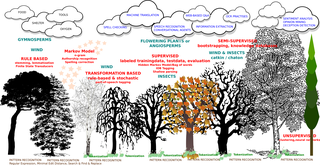
This image gives an overview of existing techniques for text analysis. By drawing them as a forest, it becomes clear how their application resembles the ecological succession of a forest. In the Brussels process of Forêt de Soignes/Zoniënwoud, the forest came to existence thanks to pioneer species after the last Ice Age. These species can survive on very harsh soil. They grow fast. As they don’t need much to live, produce and reproduce, they are very efficient fertilizers and prepare the soil for other more complex species to come.
The natural cycle of a Northwest European forest ends with the beech. Once the beech gets in, this tree will soon dominate the place. Beeches have the particular capacity of covering up all possible light spots with their extended crown. Their leaves are thick and in fall they don’t transform rapidly into humus, as leaves of other species do. In the Forêt de Soignes the beeches have been planted since the 19th century. The dominance is artificial, but representative. At the end stage of a forest, one tends to forget about all the species that were necessary to come to this stage. The beech therefore suits as a metaphor for algorithmic packages you get off the shelve, without even looking at what they’re made of.
The last tree of the image is an abstract one, representing the Arboretum, where people experiment with new species. At this very moment, the Neural Networks have just escaped from the Arboretum. They are so successful people did not wait for proper evaluation methods before starting to use them.
—
I present this image as a contribution to ’elif n°1 : Résistance électronique, stratégie éditoriale et cyberféminisme’, a seminar reserved for students of Ensba Lyon and Esad Saint-Etienne, on 29 and 30th March 2016.
The lecture is a next step in the research on ‘Algorithmic Storytellers’ and a way to show the interdependent behaviours of probabilistic models.
Other guests are: Stéphane Lemercier (artist), Eric Watier (Monotone press), Manuel Schmalstieg (Greyscale Press), Sarah Garcin and Angeline Ostellini (G.U.I), Loraine Furter (Hybrid Consortium), Anne Laforet (artist and theory), Ludivine Loiseau and Stéphanie Vilayphiou (OSP).
This research is supported by the Vlaamse Overheid. ![]()
Leave a Reply
You must be logged in to post a comment.